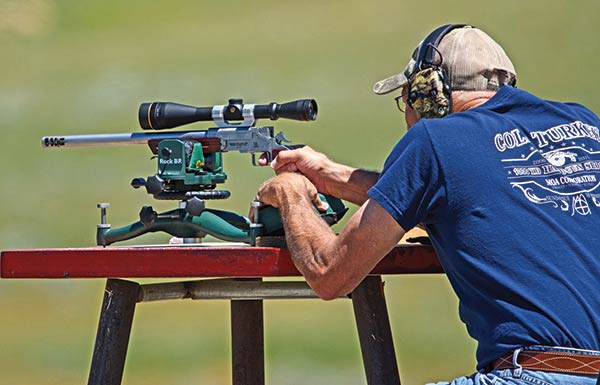Competition Vs. Hunting?
Over the years, I’ve found serious competition shooters are not generally serious hunters. Your dyed-in-the-wool hunters, those who consider hunting a passion, are seldom dedicated competition shooters. There’s some cross-over, but a tiny percentage. Perhaps hunting has very little to do with making someone a better competitor. But what about shooting competition? Does it make you a better hunter?
My wife and I just returned from a long-range handgun match in Sundance, Wyoming. It’s called the MOA Cold Turkey Match and targets are engaged from 500, 750 and 1,000 yards. Competitors are shooting from a bench, not exactly practical in hunting situations. We’re shooting at known distances too, again not especially practical in the field unless using a range finder. At the match, shooters employ different types of rests depending upon classification. There are three divisions: Light Gun, Heavy Gun and Hunter Class, each having their own definition.
It’s a three-day shoot, with each day involving all three classes from one distance. We shoot 500 yards on day one, 750 yards on day two and 1,000 yards on the final day. Neither Karen nor I consider ourselves competitive shooters but we really like this match. It’s a lot of fun, with a great group of shooters. After the match this year we rehashed the event on the drive back home, and both of us came away with a new perspective. In some ways, this long-range match may have benefits when hunting season rolls around.
The Pressure’s On
When we’re shooting at the farm practicing for an upcoming hunt, we’re alone. The shooting sessions are relaxed, informal and we remain in our comfort zone. If I miss an easy shot on a close-range steel target, no one around gets to witness this embarrassing blunder. It’s a laid-back, recreational shooting experience with no time element and no pressure at all. This isn’t exactly the same mental state you would expect when a massive 10-point buck suddenly appears in the food plot. So does this type of shooting session really prepare a person for hunting season?
During the MOA Match, eight competitors are on the line at the same time, and each of them has a muzzle brake on their handgun. Depending on the angle of the brake, the muzzle blast often blows toward adjacent shooters. This can be a distraction if you’re not careful. The clock is also ticking. Shooters have a defined amount of time to fire five rounds. There’s ample time to achieve this volley but you will know the clock is running. By now, I’m out of my comfort zone.
Pressure is sometimes self-inflicted. While we’re not shooting for a $50,000 prize, everyone wants to shoot well. Targets will be reviewed, and sometimes I would like to burn mine before anyone gets to see the group — often referred to as a “pattern” it seems! Three, 5-shot groups at extended range often separate the men from, well — we mere mortals. If you have an ounce of competitiveness in your bones, you will feel a little pressure. The top two shooters in each relay will meet again in a shoot-off and a little more pressure.
Gusty Grappling
One thing you can count on in Wyoming is the wind. We seldom get to shoot without some degree of wind and it’s rarely consistent, constantly changes direction and speeds. The wind may be coming from one direction at the shooting benches, while gusting in another direction at the wind flags by the targets. Spotters are a key component of successful shooters. Not only is wind a nemesis, mirages can also be unfriendly. Karen and I discovered a sharp learning curve, indeed. It’s incredible to see how far your bullet will drift in windy conditions at 1,000 yards!
Before the match I spent considerable time at the loading bench. Honestly, if it weren’t for this competition, I would not have taken the time to develop loads, experimenting with different powders, bullets, primers and brass. Karen and I both spent a lot of time behind the trigger preparing for this shoot. We wouldn’t have practiced so much otherwise.
We also spent a lot of time looking through optics. Sightron, Vortex and Leupold scopes were mounted on our handguns. All of the optics performed well and we gained a better understanding about optics from shooting many rounds at long range.
I don’t plan on shooting game at these extended ranges but if I can get within 300 yards of an antelope this fall, it will seem like a chip-shot after shooting 1,000 yards! Will competition help you become a better hunter? Give it a shot and find out for yourself.
For more info: www.moaguns.com






